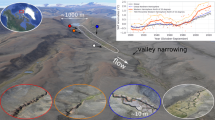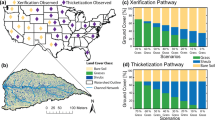Abstract
Bedrock river incision drives the development of much of Earth’s surface topography1,2,3, and thereby shapes the structure of mountain belts4 and modulates Earth’s habitability through its effects on soil erosion5, nutrient fluxes6 and global climate7. Although it has long been expected that river incision rates should depend strongly on precipitation rates, quantifying the effects of precipitation rates on bedrock river incision rates has proved difficult, partly because river incision rates are difficult to measure and partly because non-climatic factors can obscure climatic effects at sites where river incision rates have been measured8,9. Here we present measurements of river incision rates across one of Earth’s steepest rainfall gradients, which show that precipitation rates do indeed influence long-term bedrock river incision rates. We apply a widely used empirical law for bedrock river incision3,9,10,11 to a series of rivers on the Hawaiian island of Kaua‘i, where mean annual precipitation ranges from 0.5 metres to 9.5 metres (ref. 12)—over 70 per cent of the global range13—and river incision rates averaged over millions of years can be inferred from the depth of river canyons and the age of the volcanic bedrock. Both a time-averaged analysis and numerical modelling of transient river incision reveal that the long-term efficiency of bedrock river incision across Kaua‘i is positively correlated with upstream-averaged mean annual precipitation rates. We provide theoretical context for this result by demonstrating that our measurements are consistent with a linear dependence of river incision rates on stream power, the rate of energy expenditure by the flow on the riverbed. These observations provide rare empirical evidence for the long-proposed coupling between climate and river incision, suggesting that previously proposed feedbacks among topography, climate and tectonics may occur.
This is a preview of subscription content, access via your institution
Access options
Subscribe to this journal
Receive 51 print issues and online access
$199.00 per year
only $3.90 per issue
Buy this article
- Purchase on Springer Link
- Instant access to full article PDF
Prices may be subject to local taxes which are calculated during checkout




Similar content being viewed by others
References
Howard, A. D. A detachment-limited model of drainage-basin evolution. Wat. Resour. Res. 30, 2261–2285 (1994)
Whipple, K. X. Bedrock rivers and the geomorphology of active orogens. Annu. Rev. Earth Planet. Sci. 32, 151–185 (2004)
Seidl, M. A. & Dietrich, W. E. The problem of channel erosion into bedrock. Catena Suppl. 23101–124 (1992)
Willett, S. D. Orogeny and orography: the effects of erosion on the structure of mountain belts. J. Geophys. Res. Solid Earth 104, 28957–28981 (1999)
Fernandes, N. F. & Dietrich, W. E. Hillslope evolution by diffusive processes: the timescale for equilibrium adjustments. Wat. Resour. Res. 33, 1307–1318 (1997)
Riebe, C. S., Kirchner, J. W. & Finkel, R. C. Erosional and climatic effects on long-term chemical weathering rates in granitic landscapes spanning diverse climate regimes. Earth Planet. Sci. Lett. 224, 547–562 (2004)
Raymo, M. E., Ruddiman, W. F. & Froelich, P. N. Influence of late Cenozoic mountain building on ocean geochemical cycles. Geology 16, 649–653 (1988)
Snyder, N. P., Whipple, K. X., Tucker, G. E. & Merritts, D. J. Landscape response to tectonic forcing: digital elevation model analysis of stream profiles in the Mendocino triple junction region, northern California. Geol. Soc. Am. Bull. 112, 1250–1263 (2000)
Stock, J. D. & Montgomery, D. R. Geologic constraints on bedrock river incision using the stream power law. J. Geophys. Res. Solid Earth 104, 4983–4993 (1999)
Howard, A. D. & Kerby, G. Channel changes in badlands. Geol. Soc. Am. Bull. 94, 739–752 (1983)
Whipple, K. X. & Tucker, G. E. Dynamics of the stream-power river incision model: implications for height limits of mountain ranges, landscape response timescales, and research needs. J. Geophys. Res. Solid Earth 104, 17661–17674 (1999)
PRISM Climate Group. http://prism.oregonstate.edu (Oregon State University, 2006)
Poveda, G. & Mesa, O. J. On the existence of Lloro (the rainiest locality on earth): enhanced ocean-land-atmosphere interaction by a low-level jet. Geophys. Res. Lett. 27, 1675–1678 (2000)
Roe, G. H., Whipple, K. X. & Fletcher, J. K. Feedbacks among climate, erosion, and tectonics in a critical wedge orogen. Am. J. Sci. 308, 815–842 (2008)
Walling, D. E. & Webb, B. W. in Background to Hydrogeology (ed. Gregory, K. J.) 69–100 (Wiley, 1983)
Burbank, D. W. et al. Decoupling of erosion and precipitation in the Himalayas. Nature 426, 652–655 (2003)
Dadson, S. J. et al. Links between erosion, runoff variability and seismicity in the Taiwan orogen. Nature 426, 648–651 (2003)
Reiners, P. W., Ehlers, T. A., Mitchell, S. G. & Montgomery, D. R. Coupled spatial variations in precipitation and long-term erosion rates across the Washington Cascades. Nature 426, 645–647 (2003)
Moon, S. et al. Climatic control of denudation in the deglaciated landscape of the Washington Cascades. Nature Geosci. 4, 469–473 (2011)
von Blanckenburg, F. The control mechanisms of erosion and weathering at basin scale from cosmogenic nuclides in river sediment. Earth Planet. Sci. Lett. 237, 462–479 (2005)
Riebe, C. S., Kirchner, J. W., Granger, D. E. & Finkel, R. C. Minimal climatic control on erosion rates in the Sierra Nevada, California. Geology 29, 447–450 (2001)
Bookhagen, B. & Strecker, M. R. Spatiotemporal trends in erosion rates across a pronounced rainfall gradient: examples from the southern Central Andes. Earth Planet. Sci. Lett. 327–328, 97–110 (2012)
Leopold, L. B. & Maddock, T., Jr The Hydraulic Geometry of Stream Channels and some Physiographic Implications (US Geological Survey Professional Paper 252, 1953)
Montgomery, D. R. & Gran, K. B. Downstream variations in the width of bedrock channels. Wat. Resour. Res. 37, 1841–1846 (2001)
Dunne, T. & Leopold, L. B. Water in Environmental Planning (W. H. Freeman, 1978)
McDougall, I. Age of shield-building volcanism of Kauai and linear migration of volcanism in the Hawaiian Island chain. Earth Planet. Sci. Lett. 46, 31–42 (1979)
Sherrod, D. R., Sinton, J. M., Watkins, S. E. & Brunt, K. M. Geologic Map of the State of Hawai’i Sheet 2 of 8 (US Geological Survey Open-File Report 2007-1089, 2007)
Garcia, M. O. et al. Petrology, geochemistry and geochronology of Kaua‘i lavas over 4.5 Myr: implications for the origin of rejuvenated volcanism and the evolution of the Hawaiian plume. J. Petrol. 51, 1507–1540 (2010)
Waiawa 943 Climate Summaryhttp://www.wrcc.dri.edu/cgi-bin/cliMAIN.pl?hi9253 (Western Regional Climate Center, Desert Research Institute, 2011)
Mount Waialeale Climate Summary 1047http://www.wrcc.dri.edu/cgi-bin/cliMAIN.pl?hi6565 (Western Regional Climate Center, Desert Research Institute, 2011)
Chadwick, O. A. et al. The impact of climate on the biogeochemical functioning of volcanic soils. Chem. Geol. 202, 195–223 (2003)
Clague, D. A. & Dalrymple, G. B. Age and petrology of alkalic postshield and rejuvenated-stage lava from Kauai, Hawaii. Contrib. Mineral. Petrol. 99, 202–218 (1988)
Gayer, E. Mukhopadhyay, S. & Meade, B. J. Spatial variability of erosion rates inferred from the frequency distribution of cosmogenic 3He in olivines from Hawaiian river sediments. Earth Planet. Sci. Lett. 266, 303–315 (2008)
Ferrier, K. L. et al. Covariation of climate and long-term erosion rates across a steep rainfall gradient on the Hawaiian island of Kaua‘i. Geol. Soc. Am. Bull. http://dx.doi.org/10.1130/B30726.1 (in the press)
Gesch, D. et al. The National Elevation Dataset. Photogramm. Eng. Remote Sensing 68, 5–11 (2002)
Brocklehurst, S. H. & Whipple, K. X. Glacial erosion and relief production in the Eastern Sierra Nevada, California. Geomorphology 42, 1–24 (2002)
O'Callaghan, J. F. & Mark, D. M. The extraction of drainage networks from digital elevation data. Computer Vision Graph. Image Process. 28, 323–344 (1984)
Wobus, C. et al. in Tectonics, Climate, and Landscape Evolution (eds Willett, S. D., Hovius, N., Brandon, M. T. & Fisher, D. M.) Vol. 398, 55–74 (Geological Society of America Special Papers, 2006)
Daly, C., Gibson, W. P., Taylor, G. H., Johnson, G. L. & Pasteris, P. A knowledge-based approach to the statistical mapping of climate. Clim. Res. 22, 99–113 (2002)
Press, W. H. Teukolsky, S. A., Vetterling, W. T. & Flannery, B. P. Numerical recipes in C 2nd edn (Cambridge Univ. Press, 1992)
Seidl, M. A., Dietrich, W. E. & Kirchner, J. W. Longitudinal profile development into bedrock—an analysis of Hawaiian channels. J. Geol. 102, 457–474 (1994)
US Geological Survey USGS Water Data for the Nationhttp://waterdata.usgs.gov/nwis (National Water Information System, 2012)
Wohl, E. & David, G. C. L. Consistency of scaling relations among bedrock and alluvial channels. J. Geophys. Res. Earth Surf.. 113,http://dx.doi.org/10.1029/2008jf000989 (2008)
Acknowledgements
This study was supported by the Massachusetts Institute of Technology. We thank M. Slosberg for assistance with topographic analyses, S. Willett for comments that improved the manuscript and M. Rosener, S. Mukhopadhyay, M. Lamb, B. Mackey, J. Scheingross, J. Stock and C. Blay for field assistance and discussions. We thank the State of Hawaii Agribusiness Development Corporation, Landis Ignacio of the Kekaha Agriculture Association, the State of Hawaii Department of Land and Natural Resources, Divisions of State Parks and of Forestry and Wildlife, the US Fish and Wildlife Service and the Alapai and Napolis families for field access.
Author information
Authors and Affiliations
Contributions
K.L.F. and K.L.H. performed the topographic analyses, K.L.H. and J.T.P. conducted the channel evolution modelling, all authors conducted the field work and analysed the data and K.L.F. wrote the paper with input from the other authors.
Corresponding author
Ethics declarations
Competing interests
The authors declare no competing financial interests.
Supplementary information
Supplementary information
This file contains Supplementary Text and Data, Supplementary Figures 1-5 and additional references. (PDF 1131 kb)
Rights and permissions
About this article
Cite this article
Ferrier, K., Huppert, K. & Perron, J. Climatic control of bedrock river incision. Nature 496, 206–209 (2013). https://doi.org/10.1038/nature11982
Received:
Accepted:
Published:
Issue Date:
DOI: https://doi.org/10.1038/nature11982
This article is cited by
-
Landscape dynamics and the Phanerozoic diversification of the biosphere
Nature (2023)
-
Climate versus tectonics as controls on river profiles
Nature (2022)
-
A global temperature control of silicate weathering intensity
Nature Communications (2022)
-
The methods and program implementation for river longitudinal profile analysis—RiverProAnalysis, a set of open-source functions based on the Matlab platform
Science China Earth Sciences (2022)
-
Global dominance of tectonics over climate in shaping river longitudinal profiles
Nature Geoscience (2021)
Comments
By submitting a comment you agree to abide by our Terms and Community Guidelines. If you find something abusive or that does not comply with our terms or guidelines please flag it as inappropriate.



